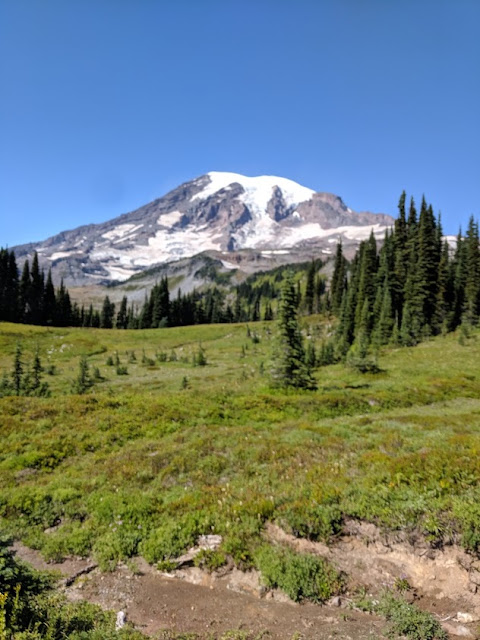On Friday August 30th, I resolved to chase a
nearby species that I’ve not tried for in over 30 years of living in Washington
State: the White-tailed Ptarmigan. These
are the smallest grouse to be found in the State, and they pretty much reside
in remote alpine meadows above about 7,000 feet. These are not a species that a birder can
just drive to; it takes a bit of effort.
I hadn’t spent much time “at elevation” for many years, and the little population
that the Oregon Game Department introduced into the Wallowas had long since
died out by the time I spent several weeks hiking there in the 1970s.
In the Pacific
Northwest, we have a phrase: “Live Like
the Mountain is Out!” On sunny days, one
or more of the peaks in The Land of the White Volcanoes are generally visible from
towns along the Cascade crest, from the Canadian border to northern
California. On days with inclement
weather, however, almost every local can point to their local mountain; whether they can see it, or not.
The local
Mountain for south Puget Sound is Mount Rainier. The concept behind the phrase is that, even
though there may be clouds and rain, you don’t wait: You live like the Mountain is Out, you will
miss out on a lot of the good things in Life.
I drove from Olympia
to Mount Rainier National Park, where the parking lot at Paradise was nearly full at 10
a.m. Clouds obscured the summit, and
visibility was pretty limited, but the day boded well for a sojourn in the
alpine heights.
 |
| Birding in a fog . . . |
There were already a lot of folks at the parking lot, and more arriving. The Park has some odd rules about parking at the Visitors' Center lots, and it took a while to find a spot - even though it wasn't all that late in the morning.
As I started on the trail, the hikers
ahead of me almost walked into this Black-tailed buck, who really didn’t pay us tourists
much attention.
The fog kept the
scenery and the birds somewhat obscured, as well.
 |
| Not much of a vista on a foggy day |
I
walked into the mist along the Panorama Point trail loop, and almost missed seeing this Sooty Grouse, which was only about 30 yards away in
the brume.
Life in the Alpine is fragile; these plants
have a very short growing period, and thoughtless hikers
can quickly trample a path into the verdure from which it will take years to recover.
 |
| The signage is a bit more clear at this site |
By about 1:30,
the heavens began to clear and the mountain was out!
Birds, however, remained
few and far between, but the meadows were ablaze with wildflowers.
 |
| Bog Gentian Gentiana calycosa |
 |
| Monkeyflower Mimulus lewisii |
 |
| Dotted Blue Euphilotes ancilla on a groundsel Senecio triangularis |
 |
| Aster Oresostemma apligenum |
Attending the
flowers was a host of insects.
Butterflies seemed to be the most abundant, and as the day warmed and
dried, the more came out.
 |
|
I think this is Edith's Checkerspot Euphydryas editha
|
 |
| And, I think this one is the Mormon Fritillary Speyeria mormonia |
 |
| Azure Celastrina echo |
Along the loop, a
pair of hikers were scanning a montane hillside.
I stopped to enquire about their view, and
they pointed out a black bear across the canyon.
 |
| The black spot in the distance is a bear. Really . . . |
I observed that much of the mountainside above the treeline showed the effect of recent loss of glaciation and snowpack. Don't believe those who say "there's no such thing as Climate Change" . . .
 |
| The glacier was down here not too many years ago . . . |
My “target” of
seeing the Ptarmigan was not realized today, but it was exhilarating to be back
at elevation, and makes me realize that I need to spend a lot more time in the
Washington Cascades. As far as seeing
this “chicken”, both Paradise and Sunrise areas at Mount Rainier should be good
locales for finding ptarmigan. The
Ptarmigan Ridge near Mount Baker is said to be one of the more accessible
places to spot one. Other potential
hikes would be to Crater Mountain in the Pasayten, and along the Pacific Crest
Trail near Harts Pass, the highest elevation you can drive to in
Washington. I may not get back up here
this year, but the Mountain has inspired me to return to the heights.

“But the darkest
scriptures of the mountains are illumined with bright passages of love that
never fail to make themselves felt when one is alone.”
John Muir - 1880
In the Heart of the California Alps
 |
| Pipit |
Mount Rainier National Park eBird Checklist is Here
 |
| Bolete |




























I love the mountain fauna and flora! Good report! Interesting observations and cool photos. There is always something interesting in the mountains! I photographed similar landscapes in the Tatras.
ReplyDelete